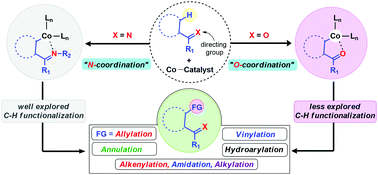O-Directed C–H functionalization via cobaltacycles: a sustainable approach for C–C and C–heteroatom bond formations
Abstract
This review focuses on providing comprehensive highlights of the recent advances in the field of cobalt-catalysed C–H functionalization and related synthetic concepts, relying on these through oxygen atom coordination. In recent years, 3d transition metal (Fe, Co, Cu & Ni) catalysed C–H functionalization reactions have received immense attention on account of its higher abundance and low cost, as compared to noble metals such as Ir, Rh, Ru and Pd. Among the first-row transition metals, cobalt is one of the extensively used metals for sustainable synthesis due to its unique reactivity towards the functionalization of inert C–H bonds. The functionalization of the inert C–H bond necessitates a proximal directing group. In this context, strongly coordinating nitrogen atom directed C–H functionalizations have been well explored. Nevertheless, strongly coordinating nitrogen-containing scaffolds, such as pyridine, pyrimidine, and 8-aminoquinoline, have to be installed and removed in a separate process. In contrast, C–H functionalizations through weakly coordinating atoms, such as oxygen, are largely underdeveloped. Since the oxygen atom is a part of many readily available functional groups, such as aldehydes, ketones, carboxylic acids, and esters, it could be used as directing groups for selective C–H functionalization reactions without any modification. Thus, the use of 3d transition metals, such as cobalt, along with weakly coordinating (oxygen) directing groups for C–H functionalization reactions are more sustainable, especially for the large-scale production of pharmaceuticals in industries. During the last decade, notable progress has been made using this concept. Nonetheless, almost all the reports are restricted to the formation of C–C and C–N bond. Therefore, there is a wide scope for developing this area for the formation of other bonds, such as C–X (halogens), C–B, C–S, and C–Se.



 Please wait while we load your content...
Please wait while we load your content...